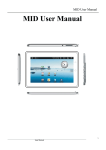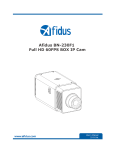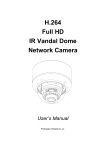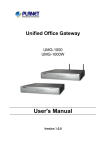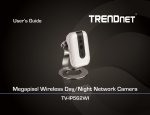Download AirLive CW-720IR/CU
Transcript
CW-720IR CU-720IR 720P Day/Night Wireless IPCAM 720P Day/Night Passive PoE IPCAM User’s Manual Copyright and Disclaimer Copyright & Disclaimer No part of this publication may be reproduced in any form or by any means, whether electronic, mechanical, photocopying, or recording without the written consent of OvisLink Corp. OvisLink Corp. has made the best effort to ensure the accuracy of the information in this user’s guide. However, we are not liable for the inaccuracies or errors in this guide. Please use with caution. All information is subject to change without notice This product contains some codes from GPL. In compliance with GPL agreement, AirLive will publish the GPL codes on our website. Please go to www.airlive.com and go to the "Support->GPL" menu to download source code. All Trademarks are properties of their respective holders. i AirLive CW-720IR / CU-720IR User’s Manual Copyright and Disclaimer FCC Statement Federal Communication Commission Interference Statement This equipment has been tested and found to comply with the limits for a Class B digital device, pursuant to Part 15 of the FCC Rules. These limits are designed to provide reasonable protection against harmful interference in a residential installation. This equipment generates uses and can radiate radio frequency energy and, if not installed and used in accordance with the instructions, may cause harmful interference to radio communications. However, there is no guarantee that interference will not occur in a particular installation. If this equipment does cause harmful interference to radio or television reception, which can be determined by turning the equipment off and on, the A user is encouraged to try to correct the interference by one of the following measures: Reorient or relocate the receiving antenna. Increase the separation between the equipment and receiver. Connect the equipment into an outlet on a circuit different from that to which the receiver is connected. Consult the dealer or an experienced radio/TV technician for help. FCC Caution Any changes or modifications not expressly approved by the party responsible for compliance could void the user's authority to operate this equipment. This device complies with Part 15 of the FCC Rules. Operation is subject to the following two conditions: (1) This device may not cause harmful interference, and (2) this device must accept any interference received, including interference that may cause undesired operation. For product available in the USA/Canada market, only channel 1~11 can be operated. Selection of other channels is not possible. This device and its antenna(s) must not be co-located or operation in conjunction with any other antenna or transmitter. FCC Radiation Exposure Statement This equipment complies with FCC radiation exposure limits set forth for an uncontrolled environment. This equipment should be installed and operated with minimum distance 20cm between the radiator & your body. WEEE Marking Warning: The crossed out wheeled bin indicates the product must not be disposed together with household waste. For the sake of the environment, the product should only be given to entities involved in the reception of waste electronic and electrical equipment. The lists of entities entitled to receive used equipment can be found on the websites of municipalities. Some components of devices such as external wiring, circuit boards and liquid crystal displays have a negative impact on the environment. AirLive CW-720IR / CU-720IR User’s Manual ii Table of Contents Table of Contents 1. Overview .....................................................................................................1 1.1 Introduction ..........................................................................................1 1.2 Features...............................................................................................2 1.3 Product Specification ...........................................................................2 1.4 System Requirement ...........................................................................5 2. Package Contents and Installation...........................................................6 2.1 Package Content .................................................................................6 2.2 Connectors ..........................................................................................6 2.3 Install the Camera................................................................................8 2.4 Connect to IP Camera .........................................................................9 3. Using IP Camera via Web Browser.........................................................11 3.1 Windows Web Browser......................................................................11 4. Operating IP Camera via Mobile Device.................................................12 4.1 Using IP Camera via iOS/Android Device..........................................12 5. Operating the Network Camera ..............................................................15 5.1 Live View............................................................................................15 5.2 Configuration .....................................................................................16 6. Configuration ...........................................................................................17 6.1 Network..............................................................................................18 6.2 Camera ..............................................................................................26 6.3 System...............................................................................................28 6.4 Video..................................................................................................32 6.5 Audio.................................................................................................36 6.6 User ...................................................................................................37 iii AirLive CW-720IR / CU-720IR User’s Manual Table of Contents 6.7 Protocol..............................................................................................37 6.8 E-Mail.................................................................................................38 6.9 Event Detection .................................................................................39 6.10 Storage............................................................................................40 6.11 Continuous Recording......................................................................41 6.12 Recording List ..................................................................................42 6.13 Event Server ...................................................................................43 6.14 Event Schedule................................................................................45 AirLive CW-720IR / CU-720IR User’s Manual iv 1. Overview 1 1. Overview This user’s manual explains how to operate this camera. Users should read this manual completely and carefully in advance. 1.1 Introduction AirLive CW-720IR/CU-720IR is a 720P network camera which is designed for indoor and home security applications even more the SMB surveillance. The built-in IR LED provides better quality of night time monitoring. Users are able to view live video streaming over wire/wireless connection or equipped with Passive PoE function which allows power and data to be transmitted via single Ethernet cable. * Wireless function is for CW-720IR only. * Passive PoE is for CU-720IR only (POE-1P Injector). 1 AirLive CW-720IR / CU-720IR User’s Manual 1. Overview 1.2 Features The main features of CW-720IR and CU-720IR. z z z z z z z z z z z z z z H.264 and MJPEG encoder Up to 30fps at all resolution One piece IR LED for day and night surveillance IEEE 802.11n WLAN/WPS for CW-720IR 12V Passive PoE for CU-720IR Compatible with ONVIF Standard 3D Noise Reduction Support Samba Server for Local Storage Event Trigger by Motion, Audio Detection, Tampering and Network Disconnect MicroSD Card Support up to 64GB ROI and Privacy Mask supported Two-Way Audio 8 Simultaneous Unicast Users Free Boundled 64-Channel Recording Software 1.3 Product Specification Model Camera Type Image Sensor Max. Resolution Camera Lens Type Night Vision IR Distance (Max.) Minimum Illumination Video Angle of View (Diagonal) Video Compression Video Mode Resolution and Frame AirLive CW-720IR / CU-720IR User’s Manual CW-720IR / CU-720IR Cube Type 1/4” CMOS Sensor 1.3M Mode: 1280x1024 720P Mode: 1280x720 3.6mm 1pc IR LED 5M Color: 0.5 Lux B/W: 0 Lux (IR On) 63° H.264 Main/Baseline Profile and MJPEG 1.3M Mode (4:3) and 720P Mode (16:9) 30fps@1280x1024 2 1. Overview Rate Streaming Image Setting ROI Digital Zoom Ethernet Network Protocols Network Users NAT Transversal Security Audio Audio Encoder Audio Streaming 30fps@1280x720 30fps@640x480 30fps@640360 30fps@320x240 30fps@160x120 30fps@160x80 Multi-profile Streaming Streaming over UDP, TCP, HTTP or HTTPs MJPEG streaming over HTTP (Server Push) Configurable frame rate and bandwidth Support CBR and VBR AE, AWB 3D Noise Reduction Exposure Value / Color Level / Brightness / Sharpness / Contrast De-Fog Lens Distortion Correction (LDC) Mirror / Flip / Rotation Auto-false Color Privacy Mask Text, Time and Date OSD 2 Windows, free scale Region of Interest Yes 10/100M Auto Negotiation 802.11n WLAN/WPS (CW-720IR) 12V Passive PoE (CU-720IR) IPv6, IPv4, TCP, UDP, HTTP, HTTPS, SMTP, FTP, NTP, DNS, DDNS, DHCP, DIPS, ARP, Bonjour, UPnP, RTSP, RTP, RTCP, IGMP, PPPoE, 3GPP, Samba, ICMP, QoS 8 Simultaneous Unicast Users UPnP NAT Transversal Password Protection IP Address Filtering HTTPS Encrypted Data Transmission User Access Log G.711 64kbps, G.726 32kbps Two-Way 3 AirLive CW-720IR / CU-720IR User’s Manual 1. Overview LED Indicator Audio Input / Output Power LED Link/Act. LED Power Supply Built-in MIC / Line Out Amber Color Green Color DC12V/1A RJ-45 10BaseT/100BaseTX 12V DC Power Jack 3.5mm Audio Output MicroSD Card Slot Reset/WPS Button Operation Temp: 0℃ ~ 40℃ Connector General Humidity: 20% ~ 80% non-condensing Storage Temp: -20℃ ~ 50℃ Environment SD card slot Software Event Triggers Motion Detection System Integration Application Programming Interface Video Buffer Alarm Events Viewing System Continuous Recording Certificate OS Browser Cell Phone Video Player AirLive CW-720IR / CU-720IR User’s Manual Humidity: 20% ~ 80% non-condensing 64GB Micro SD/SDHC CamPro Express 64, CamPro Professional Search & Installation- IP Wizard II Motion Detection Camera Tampering Audio Detection Network Disconnect Up to 10 zones OnVIF Open API for Software Integration SDK Pre / Post-alarm, up to 3MB File upload via FTP, NAS, SAMBA Server Notification via email, HTTP and TCP Audio Alerting Output (Speaker) IR LED (Night / Day mode) Save to MicroSD card Continue Recording to SD / SAMBA CE, FCC-Class B Windows® XP, Vista, 7, 8 IE 8.0 or later, Firefox, Safari, Chrome With 3GPP player VLC, Quick Time, Real Player, Core Player 4 1. Overview 1.4 System Requirement For normal operation and viewing of the network camera, it’s recommended that your system meets these minimum requirements for proper operation: Item CPU VGA Monitor RAM Operating System Web Browser Cell Phone Requirements Intel Core 2 Duo E8600(3.33GHz) or higher Resolution1280 x 1024 or higher Minimum 2 GB of RAM Window XP, Vista, 7, 8 Internet Explorer 9 or later; Apple Safari; Firefox; Google Chrome Microsoft Media Player 11.0 or later (to playback recorded file) Note: Please keep updating the latest Windows software and service package. (Ex: Net Framework, Windows Media Player, Enhance ActiveX Security) 5 AirLive CW-720IR / CU-720IR User’s Manual 2. Package Contents and Installation 2 2. Package Contents and Installation 2.1 Package Content User can find the following items in the package as below: 1. AirLive CW-720IR / CU-720IR is the main element of the product. 2. Bundle CD includes IP Wizard II, CamPro Express64, Quick Start Guide, User Manual, and Video clips. 3. Quick Start Guide provides important information and instructions for installing this device. 4. Accessory Package CW-720IR: Including crutch with screws, detachable WLAN antenna and power adaptor. CU-720IR: Including crutch with screws, power adaptor and 12V Passive PoE (POE-1P Injector). 2.2 Connectors Power Source Requirement CW-720IR: 12V/1A power adaptor. CU-720IR: 12V Passive PoE or 12V/1A power adaptor. Connector Please refer to the diagrams below for the definition of each connector. AirLive CW-720IR / CU-720IR User’s Manual 6 2. Package Contents and Installation 1. RJ45/PoE (CU-720IR) socket: Connect to Hub / Switch / PC. In the LAN socket, there are two LEDs embedded: LAN LED (Green color) Green Link Light indicates the network accessing. Power (Amber color) This LED is used to indicate whether DC power is on or not. Attention: For CU-720IR, please use 12V Passive PoE injector (POE-1P). 2. DC-in: The input power is DC12V/1A. 3. Antenna (CW-720IR): Please attach the antenna before using. 4. 3.5mm Audio output: Please insert 3.5mm speaker or earphone for audio output. 5. Reset/WPS (CW-720IR) button: 7 AirLive CW-720IR / CU-720IR User’s Manual 2. Package Contents and Installation To restore the device, please follow the steps below: 1. Turn off the Camera first. 2. Press and hold this button continuously. Power on this camera. Wait until orange LED is on. Once the Camera had been operating again, the device has been restored to default settings. Note: Restoring the factory default setting will lose the all previous settings included IP address. User needs to run the IP Wizard program to search the device. 6. SD card slot: Support up to 64GB MicroSD card. 2.3 Install the Camera Install the camera in LAN/WAN: 1. Connect an Ethernet cable to the LAN socket and attach it into the network. 2. Attach the antenna before power it up. 3. Connect the external power supply to the camera. 4. Insert the MicroSD card if necessary. 5. Attach the stand with screws. AirLive CW-720IR / CU-720IR User’s Manual 8 2. Package Contents and Installation 2.4 Connect to IP Camera 1. Insert the bundled CD into your PC/Laptop. 2. Auto Run screen pops up, click “Install Software Æ AirLive IP Wizard II” to install the configuration tool. 9 AirLive CW-720IR / CU-720IR User’s Manual 2. Package Contents and Installation 3. After completing installation, run the “Air Live IP Wizard II” to start to search the IP camera. 4. The entire detected IP camera will be listed out. 5. If the Camera’s IP address is in the same IP segment as your LAN, select the founded IP Camera and double click on the item. Then, the default browser will show up and connect to the IP camera’s Web automatically. AirLive CW-720IR / CU-720IR User’s Manual 10 3. Using IP Camera via Web Browser 3 3. Using IP Camera via Web Browser 3.1 Windows Web Browser 1. Open your web browser and enter the IP address or host name of the IP camera in the Location / Address field of your browser. 2. Use the default account “admin” and default password “airlive”. Note: The default user name “admin” and the password “airlive” are the default values. You can change them in the Security Menu. (Please check “Configuration → Security”) 11 AirLive CW-720IR / CU-720IR User’s Manual 4. Operating IP Camera via Mobile Phone 4 4. Operating IP Camera via Mobile Device 4.1 Using IP Camera via iOS/Android Device You can access to your IP camera via your iOS/Android device. Please follow the setting process below to see the live view. We take iOS system as the example: 1. Download AirLive CamPro Mobile from APP store 2. Execute AirLive CamPro Mobile 3. Click Setup button. 4. Setup page appears AirLive CW-720IR / CU-720IR User’s Manual 12 4. Operating IP Camera via Mobile Phone 5. Click Add and Auto Search button. 6. Select the camera. 7. Edit the information and User Name/Password. Click “Save”. 13 AirLive CW-720IR / CU-720IR User’s Manual 4. Operating IP Camera via Mobile Phone 8. Click “Back”. 9. Select the camera. 10. Select the channel to enlarge the video. 11. Camera live view. Note: The image is continuous snapshots, not video. Thus, live image can’t be recorded here. AirLive CW-720IR / CU-720IR User’s Manual 14 5. Operating the Network Camera 5 5. Operating the Network Camera You can operate live view function on the main page, please refer to the description below: 5.1 Live View 1. Language CW-720IR / CU-720IR support multi-language. 15 AirLive CW-720IR / CU-720IR User’s Manual 5. Operating the Network Camera 2. View Options It is a pull-down list for video streaming. 3. Streaming The device supports multi-profile function for H.264 and MJPEG simultaneously. User can choose the proper and/or preferred profile which is listed here. 4. Protocol User can select proper streaming protocol according to network environment. 5. Original size / Preview Size Switches live image view between original size (Depends on main stream setting) and preview size (640x480). 6. Digital Zoom You can see larger objects in video. Note: The digital zoom uses computer algorithm to enlarge the video and may lose some details. 7. Snapshot Take a snapshot and save images into your computer. 8. Record Press Record button to start recording and press Stop to terminate the recording. 9. Speaker / Microphone You can enable or disable the speaker/microphone function here. After enable any of these two function, you can adjust the volume by dragging the bar. 5.2 Configuration Click “Configuration” for the camera’s detail settings. For more information, please refer to Chapter 6. AirLive CW-720IR / CU-720IR User’s Manual 16 6. Configuration 6 6. Configuration Click the “Configuration” to display sub-menus included: Network / Camera / System / Video / Audio / User / Protocol / E-mail / Event Detection / Storage / Continuous Recording / Recording List / Event Server / Event Schedule 17 AirLive CW-720IR / CU-720IR User’s Manual 6. Configuration 6.1 Network In this menu, you can configure network function here. 1. Network This section provides the menu for connecting the device through Ethernet cable. Obtain IP address automatically (DHCP): Stands for Dynamic Host Configuration Protocol. Enable this check box when a DHCP server is installed in the network and the IP address will be assigned automatically. If this device cannot get an IP address within limited tries, the device will be assigned a default IP address: 192.168.1.100. IP address, Subnet mask, and Gateway: If you didn’t select DHCP, you need to enter these parameters manually. Obtain DNS from DHCP: Enable this check box when a DHCP server is installed in the network and provide DNS service. AirLive CW-720IR / CU-720IR User’s Manual 18 6. Configuration Primary DNS and Secondary DNS: If you didn’t select Obtain DNS from DHCP, you need to enter these parameters manually. HTTP Port: User can change the HTTP port number here and remote side users have to follow the port number to login. If the HTTP port is not 80, user has to add the port number in the end of IP address like http://192.168.1.100:8080. If multiple devices are installed on the LAN and also required to be accessed from the WAN, then the HTTP Port can be assigned as the virtual server port mapping to support multiple devices. Click “OK” to save and enable the setting. 2. Wireless (Only for CW-720IR) This function is only available for the model with WLAN capability. WPS: You need another WPS device to complete the connection. To activate WPS function, please follow the steps below: 1. Power on your wireless router first and make sure it working. 2. Make sure the Camera is operating normally. 3. Respectively press WPS buttons of wireless router and Camera within a short time. Then, wait a while and the wireless router will configure this camera WLAN setting automatically. Setting (Easy Installation): There are 2 easy steps to complete the connection. Please follow the instructions on the screen. Step1: Please click the table to choose the SSID. Step2: Enter the Encryption key based on the security mode you choose and click “Submit” to active the wireless setting. Site Survey: It will list all the available access point and click “Reload” to refresh the information. Access points with a disabled SSID Broadcast will not appear unless the camera is associated with it. 19 AirLive CW-720IR / CU-720IR User’s Manual 6. Configuration MAC address: It shows the MAC address of this product and it is not changeable. Interface Select: You can choose wired connection only or wired connection first. Type: You can select one of WLAN modes from Ad-hoc, Infrastructure or Wi-Fi Direct mode. SSID: This is the name of the network device which you want to connect with. Click the SSID which shown on the site survey list or enter it manually. The name must be the same as the one used in the wireless LAN or the connection will be failed. Security mode: Select the security type of the network. None WEP WPA_PSK/WPA2_PSK Authentication: Select Open or Shared Key System Authentication, depending on the method used by your access point. Not all access points have this option, in which case they probably use Open System, which is sometimes known as SSID Authentication. WEP Mode: The key types available depend on the access point being used. The following options are available: ASCII - In this method the string must be exactly 5 characters for 64-bit WEP and 13 characters for 128-bit WEP. HEX - In this method the string must be exactly 10 hexadecimal (0-9, A-F) characters for 64-bit WEP and 26 hexadecimal characters for 128-bit WEP. Web Key 1~4: Key value of WEP mode. AirLive CW-720IR / CU-720IR User’s Manual 20 6. Configuration WPA settings/ WPA Key: Key value of WPA. The device uses a pre-shared key (PSK) for key management. The pre-shared key can be entered either as manual hex, or could be 64 hexadecimal characters or a passphrase which using 8 to 63 ASCII characters. Obtain IP address automatically (DHCP): Stands for Dynamic Host Configuration Protocol. Enable this check box when a DHCP server is installed in the network and the IP address will be assigned automatically. 3. IPv6 IPv6: To enable or disable the IPv6 service here. 4. HTTPS To enable or disable the HTTPS service here. Note that the HTTPS function of this device is not only encrypted the web content but also audio/video data. If the HTTPS is enabled, there is further option for “HTTP&HTTPS” or “HTTPS only”. In case, the “HTTPS only” is enabled, all packets from the Camera will go through HTTPS only and HTTP service is no longer available. Port: Choose the HTTPS port. The default value is 443. 5. DDNS DDNS: Stands for Dynamic Domain Name Server DDNS: To enable or disable the DDNS service here. Server name: Choose the built-in DDNS server. DDNS Host: The domain name is applied of this device. User name: The user name is used to log into DDNS. Password: The password is used to log into DDNS. 21 AirLive CW-720IR / CU-720IR User’s Manual 6. Configuration 6. PPPoE PPPoE: Stands for Point to Point Protocol over Ethernet PPPoE: To enable or disable the PPPoE service here. User name: Type the user name for the PPPoE service which is provided by the ISP. Password: Type the password for the PPPoE service which is provided by the ISP. IP address, Subnet mask, and Gateway (read only): Shows the IP information got from PPPoE server site. Status: Show the Status of PPPoE connection. 7. Streaming RTSP Port: Choose the RTSP port. The RTSP protocol allows a connecting client to start a video stream. Enter the RTSP port number to use. The default value is 554. RTP Port: Specify the range of transmission port number of video stream. The default range is 50000 to 50999. User can specify a number between 1024 and 65535. 8. UPnP Universal Plug and Play. It is a networking architecture that provides compatibility among networking equipment, software, and peripherals. This device is an UPnP enabled Network Camera. If your operating system is UPnP enabled, the device will automatically be detected and a new icon will be added to “My Network Places.” If you do not want to use the UPnP functionality, it can be disabled. UPnP: To enable or disable the UPnP service here. AirLive CW-720IR / CU-720IR User’s Manual 22 6. Configuration Friendly Name: It shows the friendly name of this device here. UPnP NAT Traversal When enabled, the device will attempt to configure port mapping in a NAT router on your network, using UPnP™. Note that UPnP™ must be enabled in the NAT router first. Port Range: The port range will open in NAT router. External IP address: Show the IP address and port for WAN access through Internet. If NAT traversal is configured successfully, user can use this IP address and port to access this device. The external IP address is not shown in case NAT traversal function is failed. 9. Bonjour Bonjour, also known as zero-configuration networking, enables automatic discovery of computers, devices, and services on IP networks. Bonjour uses industry standard IP protocols to allow devices to automatically discover each other without the need to enter IP addresses or configure DNS servers. Specifically, Bonjour enables automatic IP address assignment without a DHCP server, name to address translation without a DNS server, and service discovery without a directory server. Bonjour is an open protocol which Apple has submitted to the IETF as part of the ongoing standards-creation process. Bonjour: To enable or disable the Bonjour service here. Friendly Name: It shows the friendly name of this device here. 10. IP Filter You can choose several different users’ IP address which are allowed or denied by the camera. IP Filter: To enable or disable the IP filter function here. 23 AirLive CW-720IR / CU-720IR User’s Manual 6. Configuration IP Filter Policy: Choose the filter policy. 11. IP Notification In case the IP address is changed, system is able to send out an email to alert someone if the function is enabled. SMTP Notification (e-mail): If enable this function, then the “Send to” and “Subject” fields need to be filled. Send To: Type the receiver’s e-mail address. This address is used for reply mail. Subject: Type the subject/title of the E-mail. TCP Notification: If enable this function, then the “TCP Server“, “TCP Port”, and “Message” fields need to be filled. TCP Server: Type the server name or the IP address of the TCP server. TCP Port: Set port number of TCP server. Message: The message will be sent to FTP server. HTTP Notification: If enable this function, then the fields below need to be filled. URL: Type the server name or the IP address of the HTTP server. HTTP Login name: Type the user name for the HTTP server. HTTP Login Password: Type the password for the HTTP server. AirLive CW-720IR / CU-720IR User’s Manual 24 6. Configuration Proxy Address: Type the server name or the IP address of the HTTP Proxy. Proxy Port: Set port number of Proxy. Proxy Login name: Type the user name for the HTTP Proxy. Proxy Login Password: Type the password for the HTTP Proxy. Custom parameter: User can set specific parameters to HTTP server. Message: The message will be sent to HTTP server. 12. QoS Quality of service (QoS) is the overall performance of a telephony or computer network, particularly the performance seen by the users of the network. To quantitatively measure quality of service, several related aspects of the network service are often considered, such as error rates, bandwidth, throughput, transmission delay, availability, jitter, etc. Quality of service is particularly important for the transport of traffic with special requirements. In particular, much technology has been developed to allow computer networks to become as useful as telephone networks for audio conversations, as well as supporting new applications with even stricter service demands Live Video DSCP (0~63) Live Audio DSCP (0~63) Event/Alarm DSCP (0~63) Management DSCP (0~63) * The higher DSCP value means the higher priority. 25 AirLive CW-720IR / CU-720IR User’s Manual 6. Configuration 6.2 Camera 1. Picture Rotation: Turn the “Mirror” and “Vertical Flip” On or OFF. Select 0 degrees or 90 degrees. White Balance: Auto: Will adjust the white balance automatically. Hold: Will hold the white balance value. Color Level: Adjust the color value of the image. Hue: Adjust the hue value of the image. Brightness: Adjust the brightness value of the image. Contrast: Adjust the contrast value of the image. Sharpness: Adjust the sharpness value of the image. Defog: Decrease the influence to the video quality when fog or moisture on the cover. Anti-False Color: To correct the color cast. ICR: You can select Day/Night mode according to the environment or select Auto to do the auto switch. AirLive CW-720IR / CU-720IR User’s Manual 26 6. Configuration Current Value (Red Bar): Press Refresh to have the current light sensor value. Night Mode Threshold: Select the value of switching from day to night mode. Day Mode Threshold: Select the value of switching from night to day mode. When the current value is lower than the IR on threshold, IR LED is on. When the current value is higher than the IR off threshold, IR LED is off. When the current value is between the on/off threshold, it will keep the current status. IR Off Threshold IR On Threshold Current Value Delay Time: Select the time delay of the ICR switching. LDC: Select the value of correcting the Lens distortion. 3D De-Noise: The 3D De-Noise can remove or lower the noise and keep details. This function is able to lower the bitrate a lot in low light environment. Default Settings: Restore to factory image settings. 2. Exposure Control: Power Frequency: Frequency of power line: 50 or 60Hz. Exposure Control: Auto: Will adjust the internal gain automatically. Hold: Will hold the internal gain. 27 AirLive CW-720IR / CU-720IR User’s Manual 6. Configuration Maximum Exposure Time: Set the Maximum Exposure Time. However, the real exposure time may be shorter if good light condition. Exposure Value: Exposure value is AE target value. This value is to adjust the integration, analog gain and digital gain to achieve the target brightness value (Exposure Value). This value is dependent to “Auto Exposure” only. WDR: WDR can record greater details from shadows to highlights than normal and provide clear images even under backlighting, where the intensity of illumination varies a lot. You can enable/disable this function or select the proper value. 3. Privacy Mask: Use this page to specify privacy mask window 1 to window 7 and set the name and gray level for selected window. Add and Delete: To add or delete the privacy mask windows, user can specify up to 7 windows to mask the video captured by this device. By dragging the mouse, you can change the position and size of the selected windows. Name: Define the name of the specified windows. Level Define the gray level of mask block. 6.3 System Use this menu to perform the principal settings of the device. 1. System DIPS (Dynamic IP Service): To enable or disable the DIPS® (Dynamic IP Service) function. AirLive CW-720IR / CU-720IR User’s Manual 28 6. Configuration Device ID (for DIPS): It’s a unique number of each device for identification and this ID is used for DIPS. In the Appendix G, it describes how to locate your device from Internet by DDNS service. However, we provide another easier way to do the same job called Dynamic IP Service, DIPS®. To use this service, just follow four steps below: (1) Enable DIPS function of the device (2) Check your Device ID from this page. This is a unique number for each device. (3) If your device is behind a NAT router, please configure your device properly. You could refer to section “Install the Camera behind a NAT Router” above. You only need to do this job one time. (4) Visiting our company’s web site, you can find DIPS service page as below: Enter your Device Number and press “OK” button. Then, a new web page will pop up and link to your device accordingly. You will see that DIPS is a much easier service than DDNS. Device Title: You can enter the name of this unit here. It’s very useful to identify the specific device from multiple units. The information will be shown on IP Wizard II once the device is found. Software Version: This information shows the software version of the device. Network LED: Select to turn on or off the Network LED. Power LED (Wireless LED): Select to turn on or off Power LED (wireless LED if WLAN model). Log: User can check the system log information of the device, including the Main Info, Appended Info, Operator IP, and so on … 29 AirLive CW-720IR / CU-720IR User’s Manual 6. Configuration Reload: Click this button to refresh the log information of the device. 2. Date & Time You can setup the device or make it synchronized with PC or remote NTP server. Also, you may select your time zone in order to synchronize time locally. Server Date & Time: Displays the device’s date and time. PC Time: Displays the connected PC’s date and time. Adjust: Synchronize with PC: Click this option to enable time synchronization with PC time. Manual setting: Click this option to set time and date manually. Synchronize with NTP: Click this option if you want to synchronize the device’s date and time with those of time server called NTP server (Network Time Protocol). NTP Server: Type the host name or IP address or domain name of the NTP server. NTP sync. Interval: Select an interval between 1 and 23 hours at which you want to adjust the device’s time referring to NTP server Time zone: Set the time difference from Greenwich Mean Time in the area where the device is installed. Daylight Saving: Disable or enable the daylight saving adjustment. 3. Maintenance Hard Factory Default (Include the network setting): Recall the device hard factory default settings. Note that click this button will reset all device’s parameters to the factory settings (including the IP address). AirLive CW-720IR / CU-720IR User’s Manual 30 6. Configuration Factory Default (Except the network setting): The unit is restarted and most current settings are reset to factory default values. This action will not reset the network setting. Backup Setting: To take a backup of all of the parameters, click this button. If necessary, it will then be possible to return to the previous settings, if settings are changed and there is unexpected behavior. Restore Setting: Click the “Browse” button to locate the saved backup file and then click the “Restore Setting” button. The settings will be restored to the previous configuration. Firmware Upgrade: The device supports new firmware upgrade (the software that controls the operation in the device). Please contact your dealer for the latest version if necessary. Download the latest firmware file from our website or your dealer. Unzip this firmware file to binary file and store it into your PC. Then follow the steps as bellows carefully: 1. Close all other application programs which are not necessary for firmware update. 2. Make sure that only you access this device while firmware updating. 3. Disable Motion Detection function. 4. Click “Browse” button. Select the Firmware binary file. (Note that it must make sure that the Firmware only applies to this device, once update, it will be burned into FLASH ROM of system.) 5. Once the firmware file was selected, click “Firmware Upgrade” button. 6. The upgrade progress information will be displayed. Once the uploading process completed, the device will reboot the system automatically. 7. Please wait for timer countdown, and then you can use IP Wizard II to search the device again. 31 AirLive CW-720IR / CU-720IR User’s Manual 6. Configuration Warning!!! The download firmware procedure can not be interrupted. If the power and/or network connection are broken during the download procedure, it might possibly cause serious damage to the device. Strongly suggest that DO NOT upgrade firmware via Wireless LAN due to high error rate possibly and don't allow any other clients to access this unit during updating procedure. Be aware that you should not turn off the power during updating the firmware and wait for finish message. Furthermore, the firmware upgrade procedure always is risk and do not try to upgrade new firmware if it’s not necessary. System Restart: The device is restarted without changing any of the network settings. It means the IP address of the device will not change after firmware upgrade. 6.4 Video This device provides 2 modes of video profile. The first one is 1.3Mega mode which supports video resolution up to 1.3 Mega-pixel. The second one is 720P mode which supports video resolution up to 1 Mega-pixel. User only can select either 1.3Mega or 720P mode to operate the camera. Switching 1.3Mega and 720P mode, the device will take time to reboot system. 1. Common Video Profile: User can only choose either 720P or 1.3Mega mode. 720P mode can serve streams up to 1280x720 maximum. And 1.3Mega mode can streams up to 1280x1024. Text Overlay Setting: There are some important information can be embedded into image, including date, time, and/or text. User also can change the font color, background color, transparency and position. AirLive CW-720IR / CU-720IR User’s Manual 32 6. Configuration 2. Overlay Image User can select to add image or text on the image. User Defined Text: User can define font content and choose font type, color and background color. Image Overlay Setting: User can browse the image file in the computer and upload it onto the image. The supported file type is 24-bit/16-bit RGB 1555 BMP 500KB. Coordinates: Adjust the position of the image. Chroma Key: Select the chroma of the color. Transparency: Select the transparency of the image. 3. Video Profile Name: Assign a name to the selected profile. Video Type: Select the video codec of the video profile. Resolution: Select the resolution of the video profile. ROI: Assign the selected profile as a ROI stream or not. Rate Control: Define the rate control method of this profile. There are three options: Constant Bit Rate (CBR), Variable Bit Rate (VBR) and Enhanced Variable Bit Rate (EVBR). For CBR, the video bit rate is between low to high bandwidth based on different resolutions. User can set the desired bit rate to match the limitation of bandwidth. 33 AirLive CW-720IR / CU-720IR User’s Manual 6. Configuration For VBR, user should choose the quality level to set the video quality rather than bit rate. The quality level is between 1 and 100. The higher value can reach the better quality but of course will consume higher bandwidth. For EVBR, the video bitrate is based on normal VBR mode. However, the target bitrate can be increased to max target bitrate while lots of motion in video. The max target bitrate will keep a pre-defined time period and then back to normal VBR mode. Max Frame Rate: Define the targeted frame rate of this profile. For example, set the frame rate to 15 fps, then the image will be updated for 15 frames per second as possible. User need to set reasonable max frame rate versus video quality under the limited bandwidth. GOP Control: Define the Intra/Inter-frame (I/P) ratio of this profile. For example, set the GOP to 30, then the video stream will have one Intra-frame every 30 frames. Multicast: Enable or disable the multicast function. Multicast Video: Fill in the IP address and port for multicast video streaming of the selected profile. Multicast Audio: Fill in the IP address and port for multicast audio streaming of the selected profile. Time to live: Time to live (TTL) is a mechanism that limits the lifespan of data in a computer or network. Once the prescribed event count or time span has elapsed, data is discarded. TTL prevents a data packet from circulating indefinitely. Always Enable Multicast: Multicast streaming is always enabled or by request. Warning!!! To enable the multicast streaming, you shall make sure your Intranet does support multicast function. Otherwise, your Intranet may occur network storm seriously. AirLive CW-720IR / CU-720IR User’s Manual 34 6. Configuration 4. ONVIF Profile ONVIF is a global and open industry forum with the goal to facilitate the development and use of a global open standard for the interface of physical IP-based security products. In other words, to create a standard for how IP products within video surveillance and other physical security areas can communicate with each other. Name: Assign a name to the selected profile. Video Type: Select the video codec of the video profile. Resolution: Select the resolution of the video profile. Rate Control: Define the rate control method of this profile. There are three options: Constant Bit Rate (CBR), Variable Bit Rate (VBR) and Enhanced Variable Bit Rate (EVBR). Max Frame Rate: Define the targeted frame rate of this profile. For example, set the frame rate to 15 fps, then the image will be updated for 15 frames per second as possible. User need to set reasonable max frame rate versus video quality under the limited bandwidth. GOP Control: Define the Intra/Inter-frame (I/P) ratio of this profile. For example, set the GOP to 30, then the video stream will have one Intra-frame every 30 frames. AUDIO: Enable or disable the audio transmission. Multicast Video: Fill in the IP address and port for multicast video streaming of the selected profile. Multicast Audio: Fill in the IP address and port for multicast audio streaming of the selected profile. 35 AirLive CW-720IR / CU-720IR User’s Manual 6. Configuration Time to live: Time to live (TTL) is a mechanism that limits the lifespan of data in a computer or network. Once the prescribed event count or timespan has elapsed, data is discarded. TTL prevents a data packet from circulating indefinitely. 5. ROI ROI means Region of Interest. Use this page to specify ROI window which the lowest resolution is 160x160. Please remember to enable ROI in the video setting page before the setting. Once you finished the ROI setting, you will see the ROI streaming on the screen. Save Profile1/2: Press to save a new ROI screen. You can resize and move the screen at will first. 6. AOI AOI means you can raise the video quality of specific areas. You can resize and move the screen at will. Add/Delete: You can add at most two AOI areas. Name/Level: Naming the AOI area and select proper level from -10(Worst) to 10(Best). Save: Save the AOI settings. 6.5 Audio 1. Setting Audio: To enable or disable audio function Audio Type: To select audio codec AirLive CW-720IR / CU-720IR User’s Manual 36 6. Configuration Audio Mode: To select Simplex or Full duplex (2-way audio) mode Input Gain: To adjust gain of input audio Output Gain: To adjust gain of output audio 6.6 User You can add, modify and delete the user information. 1. Setting Viewer login: Select “Anonymous” to allow any one viewing the video once connected. Otherwise, only users in database can view the video after login. Access Right: Administrator can access every function in this device. However, Viewers only can view the video and access limited function. Add, Modify, and Delete: Manage the user’s account information of users. 6.7 Protocol 1. ONVIF ONVIF: To enable or disable the ONVIF interface here. And select the ONVIF version to match client’s version. 37 AirLive CW-720IR / CU-720IR User’s Manual 6. Configuration 6.8 E-Mail You can setup SMTP parameters for further operation of Event Schedule. That’s, if users want to send out the alarm message, it will need to configure parameters here and also add at least one event schedule to enable event triggering. 1. Setting SMTP Server: Type the SMTP server name or the IP address of the SMTP server. Test: Send a test mail to mail server to check this account is available or not. SMTP Port: Set port number of SMTP service. SSL: Enable the SSL function or not. SMTP Authentication: Select the authentication required when you send an e-mail. Disable: if no authentication is required when an e-mail is sent. Enable: if authentication is required when an e-mail is sent. Authentication User name: Type the user name for the SMTP server if Authentication is enabled. Authentication Password: Type the password for the SMTP server if Authentication is enabled. E-mail To: Type the receiver’s e-mail address. E-mail From: Type the sender’s E-mail address. This address is used for reply e-mails. E-mail Subject: Type the subject/title of the e-mail. AirLive CW-720IR / CU-720IR User’s Manual 38 6. Configuration 6.9 Event Detection Use this menu to specify motion detection window 1 to window 10 and set the conditions for detection while observing a captured image 1. Motion Detection Add and Del: You can add or delete the motion windows. User can specify up to 10 Included and/or Excluded windows to monitor the video captured by this device. By dragging mouse on the image, you can change the position and size of the selected motion window accordingly. Included or Excluded Window: These windows can be specified as Included or Excluded type. Included windows target specific areas within the whole video image Excluded windows define areas within an Include window that should be ignored (areas outside Include windows are automatically ignored) Name: Give a name to the specified motion window. Object Size: Define the object size of motion detection. The higher object size will only larger objects trigger motion detection. The lower object size will even small objects trigger motion detection too. Generally speaking, the smaller size will be easier to trigger event. Sensitivity Define the sensitivity value of motion detection. The higher value will be more sensitivity. 2. Camera Tampering Camera Tampering: Select to enable or disable the camera tampering function. Minimum Duration: Select the duration time between two events. Sensitivity: Select the sensitivity of tampering, the higher value means easier to be triggered. 39 AirLive CW-720IR / CU-720IR User’s Manual 6. Configuration Status: It shows the status of this function. 3. Audio Detection Audio Detection: Select to enable or disable the audio detection function. Audio Alarm Level: The higher level means need higher volume to trigger the event. 6.10 Storage Here is to setup the storage for continuous recording function. 1. SD Card This page shows the status of attached SD card. You need to setup related parameters to manage the attached SD card also. Disk ID/Mount: Mount means to make the device accessible to the system. We suggest you to mount the SD card when before using it. Reload/Format: Select reload to refresh the information or format the SD card. Enable automatic disk cleanup: Delete old recorded files while the conditions are reached as below. Remove recordings order than: Delete old files by days. Remove oldest recordings when disk is: Delete old files by left capacity. Lock Disk: Lock the SD card to secure from format it. AirLive CW-720IR / CU-720IR User’s Manual 40 6. Configuration 2. SAMBA Server This page shows the status of SAMBA server. You need to setup related parameters to manage the remote SAMBA server. Host: Type the SAMBA server domain name or the IP address of the SMTP server. Share: Type the share folder of remote SAMBA server which the camera will upload files to this space. User name: Type the user name for the remote SAMBA server. Password: Type the password for the remote SAMBA server. Mount: Select mount to make the SAMBA server accessible. Enable automatic disk cleanup: Delete old recorded files while the conditions are reached as below. Lock Disk: Lock the SD card to secure from format it. 6.11 Continuous Recording The camera can continuously record video stream into files and save them into SD card or SAMBA server. 1. Continuous Recording Continuous Recording: Enable or disable this function. Record File Type: Choose a video profile to record. 41 AirLive CW-720IR / CU-720IR User’s Manual 6. Configuration DISK: Save recorded files to SD card or remote SAMBA server. Path: Define the folder path for the recorded files. Restart: It will delete all continuous files recorded in SD card or SAMBA server. 6.12 Recording List 1. Recording List This page shows the files list information. User may play or delete the selected file. Reload/Recover: Reload or recover the file on the list. Download/Remove: Download or remove the file on the list. 2. Continuous Recording List This page only shows the continuous recording files which stored in SD card or remote SAMBA server. User may play or delete the selected file. SD Card/SAMBA Server: Select list from SD card or SAMBA server. Start/End time: It can list out the recorded file during a specific time. Reload/Recover: Reload or recover the file on the list. Download/Remove/Play Video: Download, remove or play the file on the list. AirLive CW-720IR / CU-720IR User’s Manual 42 6. Configuration 6.13 Event Server 1. FTP Server You may setup FTP parameters for further operation of Event Schedule. That’s, if users want to send the alarm message to an FTP server, it will need to configure parameters here and also add at least one event schedule to enable event triggering as SMTP. Name: User can specify multiple FTP paths as wish. Therefore, user needs to specify a name for each FTP setting. FTP Server: Type the server name or the IP address of the FTP server. Test: Check the FTP server whether this account is available or not. FTP Login name: Type the user name for the FTP server. FTP Login Password: Type the password for the FTP server. FTP Port: Set port number of FTP service. FTP Path: Set working directory path of FTP server. FTP Passive Mode: Select passive or active mode connecting to FTP server. Protocol: Select the protocol of FTP server. 2. TCP Server In addition to send video file to FTP server, the device also can send event message to specified TCP server. Name: User can specify multiple TCP servers as wish. Therefore, user needs to specify a name for each TCP server setting. 43 AirLive CW-720IR / CU-720IR User’s Manual 6. Configuration TCP Server: Type the server name or the IP address of the TCP server. TCP Port: Set port number of TCP server. 3. HTTP Server The device also can send event message to specified HTTP server. Name: User can specify multiple HTTP servers as wish. Therefore, user needs to specify a name for each HTTP server setting. URL: Type the server name or the IP address of the HTTP server. Test: Check the HTTP server whether it is available or not. HTTP Login name: Type the user name for the HTTP server. HTTP Login Password: Type the password for the HTTP server. Proxy Address: Type the server name or the IP address of the HTTP Proxy. Proxy Login name: Type the user name for the HTTP Proxy. Proxy Login Password: Type the password for the HTTP Proxy. Proxy Port: Set port number of Proxy. 4. SAMBA Server The device also can send video stream to specified SAMBA server. AirLive CW-720IR / CU-720IR User’s Manual 44 6. Configuration Name: User can specify multiple HTTP servers as wish. Therefore, user needs to specify a name for each HTTP server setting. SAMBA Server: Type the server name or the IP address of the SAMBA server. Test: Check the SAMBA server whether this account is available or not. SAMBA Login name: Type the user name for the SAMBA server. SAMBA Login Password: Type the password for the SAMBA server. SAMBA Path: Set working directory path of SAMBA server. 6.14 Event Schedule This menu is used to specify the schedule of Event or Schedule Trigger and activate the some actions provided by this device. Where the Schedule Trigger will be activated by user-define interval without event happened. 1. Setting Name: Give a name to the Event or Schedule. Enable: Enable or disable this Event or Schedule. Type: Event trigger or Schedule trigger. 45 AirLive CW-720IR / CU-720IR User’s Manual 6. Configuration Enable Time: Define the feasible time slot. Trigger by: Select the events triggered by Motion Area, Camera Tampering, Audio Detection and Network Disconnect. Record File Prefix: Add the prefix to the file name. Action: Define the actions once event is been triggered. Please remember to setup the FTP/TCP/HTTP/E-Mail/SAMBA before you enable the action. Add/Modify/Delete: To add, modify or delete the saved event schedule 2. Record User can choose the type of record file for event or schedule application. Record File Type: Choose JPEG, AVI-JPEG, or AVI-H.264 file format. Record File Prefix: Define the prefix of recorded filename. Pre-Trigger Duration: Define the maximum duration of pre-alarm. Post-Trigger Duration: Define the maximum duration of post-alarm. Max File Size: Define the maximum buffer size of record file. AirLive CW-720IR / CU-720IR User’s Manual 46
































































